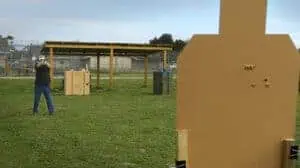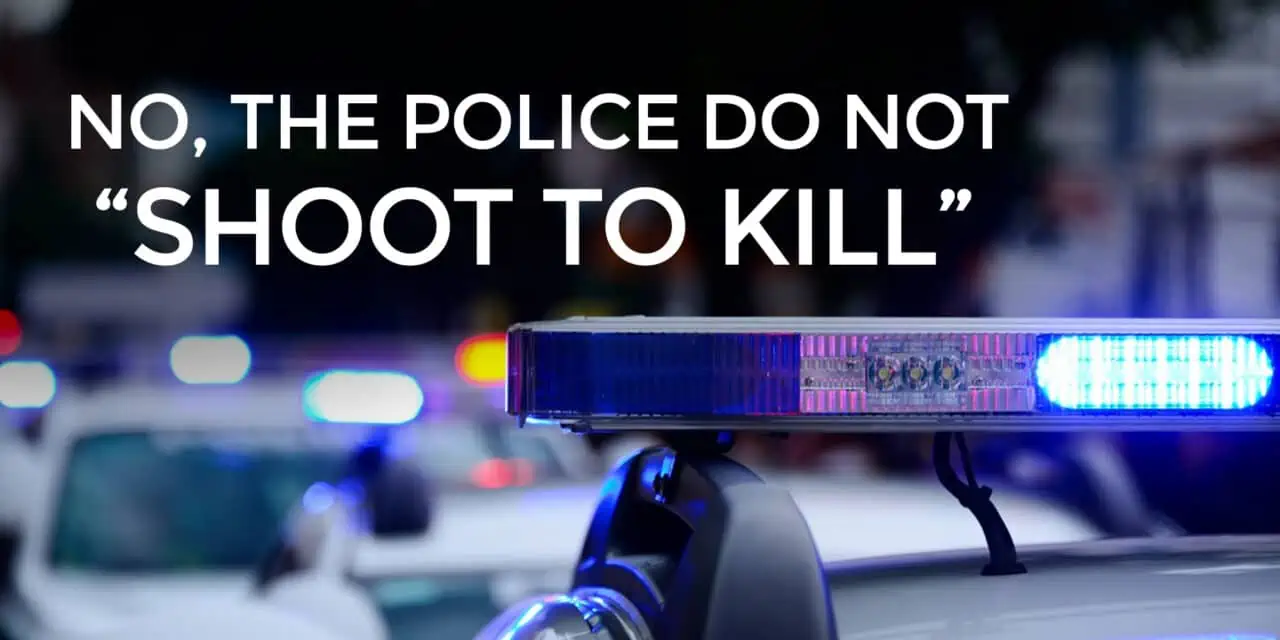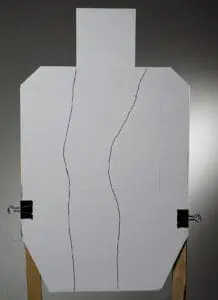“Why Do Police Shoot To Kill?” (Spoiler Alert: They Don’t)
It seems like we can’t go even a few days without some controversy brewing up in the media about police use of force. The police can (and do) use lethal force to protect us from the recklessly violent portions of society. The perceptions of how that lethal force is used, though, can occasionally cause problems with society as a whole. Let’s take a look at what handguns actually do when used to stop an attacker, and what effect that has on how the police and armed citizens use them to defend a life.
American law enforcement is exceptionally well trained. There is a gap, however, between what some people believe law enforcement should do, and what is possible in a defensive situation. The cries of “Why do police shoot to kill?” need to be countered with a cold, hard look at what happens in a defensive gun encounter.
One of the tasks of law enforcement is to end a violent encounter as quickly as possible, using an appropriate amount of force. The more time that a person can commit violence, the greater the danger to the general populace. That reality drives law enforcement training, including the use of lethal force.
What Pistols Can and Can’t Do

It’s going to take multiple hits to stop an attacker, and getting those hits under stress is quite a challenge.
Let’s begin by looking at the pistols and ammunition in common use in America and what they actually do. Greg Ellifiritz is a writer, firearms trainer and former Ohio police officer. In 2011, he compiled a list of defensive gun encounters based on publicly-available accounts. The list is from a variety of sources, not just law enforcement shootings, and includes data on the use of pistols, rifles and shotguns in a gunfight.
The data on pistols is particularly interesting. A pistol is the primary defensive firearm for law enforcement, just as it is for the armed citizen. It’s the gun that we are most likely to have nearby if we need to stop a lethal threat. According to Ellifritz’s data, however, it is not that effective when compared to a rifle or a shotgun.
| .380 ACP | .38SP | 9mm | 357 Mag/ Sig | 40 S&W | .44 Mag | .45 ACP | Avg | |
|---|---|---|---|---|---|---|---|---|
| # of People shot | ||||||||
| % of fatal hits | ||||||||
| Avg, # of rounds to incapacitate | 1.76 | 1.87 | 2.45 | 1.7 | 2.36 | 1.71 | 2.08 | 1.99 |
| % of 1 shot stops | ||||||||
| Accuracy (head and torso hits) | ||||||||
| % incapacitated by 1 shot to torso or head |
As a comparison, according to Ellifritz’s data, one shot from a rifle to the head or torso stopped an attack 81% percent of the time. One shot from a shotgun to the head or torso stopped 84% of the listed attacks. A long gun like a rifle or shotgun is much more effective, but it’s hard to carry one around with you all day long.
It’s important to note here this data does not take into account bullet type used. The rounds used in these pistols could be FMJ practice ammo or JHP defensive ammo. However, looking at these 1400+ encounters, a few things become quite clear.
- There is a very good chance it will take more than one pistol bullet to stop an attacker.
- Accuracy is fairly consistent: Three out of four shots that hit the attacker are going to hit the head and torso.
- If an attacker is going to be stopped, it’s because of a hit to the torso or head. Incapacitation rates jump up significantly once the torso and chest are targeted.
Why Police Shoot The Way They Do
I reached out to Caleb Causey of Lone Star Medics in order to get a better understanding why hits to the torso incapacitate more frequently than hits to the extremities. Caleb is a former Army Medic and has worked as an EMT and SWAT medic. I talked with him about why law enforcement officers and armed citizens are both trained to shoot at the upper center torso rather than just shooting someone in the leg.
“Physiologically, the object of shooting at an attacker is to stop them from hurting others. We want to completely stop the threat of violence as quickly as possible,” he said. “That means shutting down the brain’s ability to keep the body in the fight. The goal of the blood loss is to switch off the brain or disrupt the brain.”
“Marksmanship becomes much more difficult in a high-stress situation,” Causey continued. “The adrenaline hits our body, and that means it’s difficult to accomplish delicate tasks like a stable sight picture and a smooth trigger press. We can’t rely on the police or anyone else making a shot on a small target like a limb or a hand. We have to train to take the shot that has the best chance of hitting the target and being effective. This means we need to aim for the center-chest portion of the torso.”
“In addition to this,” Causey went on, “limbs move much more than the upper chest and are smaller targets. This makes them much harder to hit when your heart is pumping and everything is shaking, trying to deal with all the adrenaline in your veins. Even a good, solid hit in the leg or arm won’t stop the attacker from attacking. A hit there will only limit the attacker’s movement or use of that limb. Even if the round severs a major artery in an extremity, Internal bleeding in a limb or pelvis won’t cut off blood flow to the brain and shut down the attack. The best way to accomplish that is to hit the pumping station, the heart and lungs in the center of the chest.”
Why Do Police Shoot To Kill? They Don’t!
The question to ask isn’t “Why do police shoot to kill?” The question to ask is, “What’s the fastest way that the police can stop a lethal attack while minimizing the risks to innocent bystanders?” Once we ask that question, we begin to see that just “shooting them in the leg” is no longer a viable option, and aiming for the center-chest is the best option for law enforcement as well as the armed citizen.




Maybe Joe Biden should read this before mandating that cops shoot the leg.
then why are so many in the news about police shootings to many of then